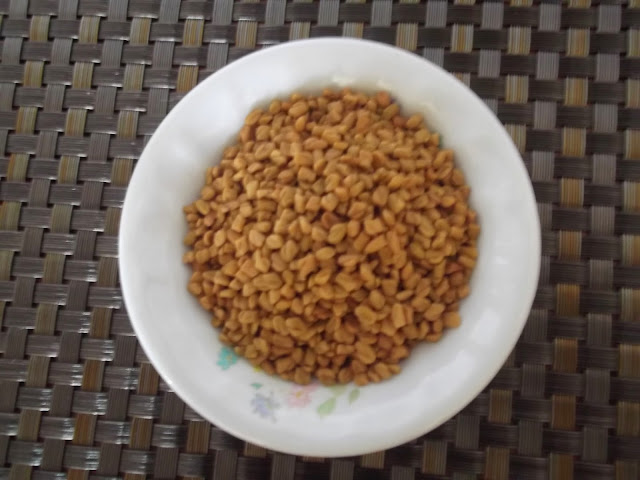This is a spice used in Indian cooking. It has a bitter taste.
Health benefits of fenugreek
Fenugreek is used for many conditions. But there is not enough scientific research evidence to justify any of these claims. These are the common beliefs.
1. Lowering of blood sugar level.
2. Lowering of cholesterol.
3. Lowering of triglycerides in people with type 2 diabetes.
4. Cure heartburn.
5. Remedy for stomach upset and constipation. Hardening of arteries.
6. Gout
7. Baldness
8. Increase in milk flow for breast feeding mothers.
9. Sometimes it is used to mask taste of medicines.
10. Extracts are used in soaps and cosmetics.
11. Helps breast enlargements.
12. Reduce menstrual pain.
13. Loosing weight.
14. Reduce fever
Usually people will take one tea spoonful of fenugreek seeds with a glass of water, preferably in the morning. Sometimes fenugreek seeds are soaked overnight in a glass of water. The infusion and the seeds are consumed in the morning in empty stomach. This will improve digestion, bowel movement and help in heat burn.
Fenugreek is commonly used as a spice and for medicinal purposes in the major producing countries such as Afghanistan, Pakistan, India, Iran, Nepal, Bangladesh, Argentina, Egypt, France, Spain, Turkey and Morocco.
In some parts of the world a cooling drink is made out of it.
It is used in small quantity due to its bitterness. It is consumed raw as well as cooked. In most recopies only a very little quantity (typically ¼ to ½ teaspoon) is used because of its bitterness.
Source: USDA
 |
| Fenugreek seeds |
Fenugreek is used for many conditions. But there is not enough scientific research evidence to justify any of these claims. These are the common beliefs.
1. Lowering of blood sugar level.
2. Lowering of cholesterol.
3. Lowering of triglycerides in people with type 2 diabetes.
4. Cure heartburn.
5. Remedy for stomach upset and constipation. Hardening of arteries.
6. Gout
7. Baldness
8. Increase in milk flow for breast feeding mothers.
9. Sometimes it is used to mask taste of medicines.
10. Extracts are used in soaps and cosmetics.
11. Helps breast enlargements.
12. Reduce menstrual pain.
13. Loosing weight.
14. Reduce fever
Usually people will take one tea spoonful of fenugreek seeds with a glass of water, preferably in the morning. Sometimes fenugreek seeds are soaked overnight in a glass of water. The infusion and the seeds are consumed in the morning in empty stomach. This will improve digestion, bowel movement and help in heat burn.
Fenugreek is commonly used as a spice and for medicinal purposes in the major producing countries such as Afghanistan, Pakistan, India, Iran, Nepal, Bangladesh, Argentina, Egypt, France, Spain, Turkey and Morocco.
In some parts of the world a cooling drink is made out of it.
It is used in small quantity due to its bitterness. It is consumed raw as well as cooked. In most recopies only a very little quantity (typically ¼ to ½ teaspoon) is used because of its bitterness.
Unit
|
|||
Value
per 100 g
|
|||
Proximates
|
|||
Water
|
g
|
8.84
|
|
Energy
|
kcal
|
323
|
|
Protein
|
g
|
23
|
|
Total lipid (fat)
|
g
|
6.41
|
|
Carbohydrate, by difference
|
g
|
58.35
|
|
Fibre, total dietary
|
g
|
24.6
|
|
Vitamins
|
|||
Vitamin C, total ascorbic acid
|
mg
|
3
|
|
Thiamin
|
mg
|
0.322
|
|
Riboflavin
|
mg
|
0.366
|
|
Niacin
|
mg
|
1.64
|
|
Vitamin B-6
|
mg
|
0.6
|
|
Folate, DFE
|
µg
|
57
|
|
Vitamin B-12
|
µg
|
0
|
|
Vitamin A, RAE
|
µg
|
3
|
|
Vitamin A, IU
|
IU
|
60
|
|
Vitamin D (D2 + D3)
|
µg
|
0
|
|
Vitamin D
|
IU
|
0
|
|
Lipids
|
|||
Fatty acids, total saturated
|
g
|
1.46
|
|
Cholesterol
|
mg
|
0
|
|
Source: USDA
No comments:
Post a Comment